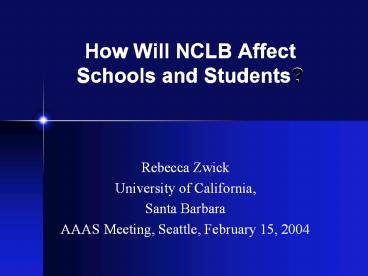How Will NCLB Affect Schools and Students? - PowerPoint PPT Presentation
1 / 20
Title:
How Will NCLB Affect Schools and Students?
Description:
Schools must show 'adequate yearly progress' for each subject area and group ... Great care must be taken to avoid unjustified imposition of sanctions. ... – PowerPoint PPT presentation
Number of Views:23
Avg rating:3.0/5.0
Title: How Will NCLB Affect Schools and Students?
1
How Will NCLB Affect Schools and Students?
- Rebecca Zwick
- University of California,
- Santa Barbara
- AAAS Meeting, Seattle, February 15, 2004
2
NCLB assessment provisions
- Grades 3-8 tested annually in math and reading by
2005-6 - All students 100 proficient by 2013-14
- Schools must show adequate yearly progress for
each subject area and group (Results are
percentage declared proficient) - At least 95 of each group to be tested
3
Results to be reported separately for groups
defined by
- Gender
- Racial/ethnic category
- English proficiency status
- Disability status
- Migrant status
- Socioeconomic status
- (US DOE, 2003)
4
NCLB Sanctions for failure to meetAYP objectives
(Title I-eligible schools)
- 2 years in a row in need of improvement
Students must be offered the chance to transfer
to another public school. - 3 years in a rowstudents must also be offered
supplemental services, e.g., tutoring. - Continued failure School is subject to
corrective measures and possibly takeover.
5
Benefits of NCLB
- Reflects national desire to improve education and
reduce achievement gap - Forces schools to focus on needs of groups that
are sometimes neglected
6
Unintended effects
- Focus on assessment can narrow instruction
- Unrealistic goals and fear of sanctions can
encourage reduction in state standards - Morale may decay because of perceived inequities
in the sanctioning process - Sanctions can lead to double jeopardy
- Legislative action opposing NCLB in Virginia,
Ohio, Utah, and North Dakota
7
Focus on assessment can narrow instruction
- Education Weeks National Survey of Public School
Teachers (see Olson, Jan. 11, 2001) - Conducted in 2000, pre-NCLB (n 1,019)
- 66 State testing leads to focus on tested
material to the detriment of other areas - 67 say there is far too much or somewhat too
much focus on tests
8
- Unrealistic goals and fear of sanctions can
encourage reduction in state standards
9
Percentage at or above NAEP Achievement Levels
Grade 4 Reading
1992 1994 1998 2000 2002 2003
Basic 62 60 60 59 64 63
Profi-cient 29 30 29 29 31 31
10
Notes to table
- 6 to 8 of each cohort reached Advanced
- SEs for tabled s range from .3 to 1.4
- All results are for accommodations allowed
conditions except 1992 and 1994.
11
Fear of sanctions provides incentives for lower
standards of proficiency
- How is NCLB proficient defined?
- Louisiana set equal to states basic
- Colorado set equal to states partially
proficient - Connecticut Set lower than states own goals
- (Source, Hoff, D., Education Week, 10/9/02)
12
- Morale may decay because of perceived inequities
in the sanctioning process.
13
Criteria for sanctions vary across states
- Tests selected or developed
- Definition of proficient
- Minimum sample size required
- Adequate yearly progress (AYP) definition and
starting points - Enforcement (waiver policies)
14
Examples of variability across states
- According to 8/6/03 Education Week
- Minimum sample size for accountability ranges
from 5 to 50 (more later) - AYP 21 accelerating 25 approx. linear
- For 2003, some states provided waivers for
schools with participation rates under 95
15
Criteria for sanctions may be unreliable
- Harsh sanctions can be triggered by results on a
single fallible indicator - Imprecision due to small samplesas small as 5
(29 states include CI or SE criteria) - Inaccuracy due to student mobility
- No credit for changes that dont affect the
percentage proficient (Linn et al., 2002)
16
Sanctions can lead to double jeopardy
- Low socioeconomic-status schools are more likely
to be judged in need of improvement. - Sanctions could then further drain school
resources. - Great care must be taken to avoid unjustified
imposition of sanctions.
17
Recommendations What can statistics and
measurement professionals offer?
- Encourage inclusion of information about sampling
and measurement error - Study the probability of misclassifying schools
under realistic assumptions. - Encourage methods that reduce the likelihood of
misclassification. - Educate school personnel and policymakers about
educational measurement statistics
18
Bibliography
- Goertz, M. E. (2001, Sept.) The federal role in
defining adequate yearly progress. Consortium
for Policy Research in Education Report. cpre.
org. - Hoff, D. J. (2002, Oct. 9). States revised
meaning of proficient. Education Week, pp. 1,
24-25. - Linn, R. L., Baker, E. L., Betebenner, D. W.
(2002). Accountability systems Implications of
requirements of the No Child Left Behind Act of
2001. Educational Researcher, 31, 3-16. - Olson, L. (2001, Jan.11). Overboard on testing?
Education Week Quality Counts 2001, pp. 23-30.
19
References (continued)
- Olson, L. (2003, Aug. 6). Approved is relative
term for Ed. Dept. Education Week, pp. 1, 34-36. - Olson, L. (2004, Jan. 7). Data doubts plague
states, federal law. Education Week, pp. 1, 26. - Rebora, A. (updated 2003, Aug. 6). No Child
Left Behind. Summary Education Week document.
edweek.com. - Rogosa, D. (1999). Accuracy of individual scores
expressed in percentile ranks classical test
theory calculations. (CSE Technical Report 509.)
cse.ucla.edu.
20
References (continued)
- Thum, Y. M. (2003). No Child Left Behind
Methodological challenges recommendations for
measuring adequate yearly progress. (CSE
Technical Report 590.) cse.ucla.edu. - US Department of Education (2003). No Child Left
Behind A Parents Guide. nclb.gov/next. - U.S. Department of Education, National Center for
Education Statistics, NAEP 2003, 2002, 2000,
1998, 1994 and 1992 Reading Assessments.































